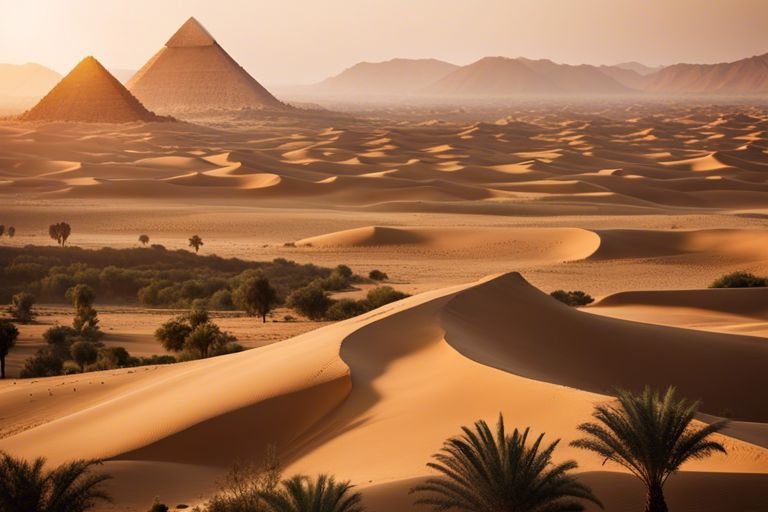Was Egypt Always a Desert? Delving into Geological History
- Home
- Was Egypt Always a Desert? Delving into Geological History

Was Egypt Always a Desert? Delving into Geological History
As an avid geology enthusiast, I have always been fascinated by the ever-changing landscapes of our planet. When it comes to Egypt, many of us picture a vast desert with towering pyramids and ancient temples. However, the geological history of this region spans over millions of years, and the truth may surprise you. In this guide, I will take you on a journey through time to explore the dramatic shifts in Egypt’s landscape, from lush forests to scorching deserts. We will delve into the impact of climate change, tectonic activity, and the role of the Nile River in shaping the land we know today. Whether you’re a history buff, a geology geek, or simply curious about the world around you, join me as we uncover the hidden geological secrets of Egypt.
Key Takeaways:
- Egypt’s geological history: Egypt was not always a desert; it has a complex geological history that involved periods of lush vegetation and changing climate conditions.
- Nile river: The presence of the Nile River has played a crucial role in shaping Egypt’s landscape and allowing civilization to thrive in the region.
- Climate change: Ancient Egypt experienced significant climate changes, leading to the transformation of its environment from a green and fertile land to the arid desert we see today.
- Geological evidence: Geological studies and evidence from fossils and sedimentary rocks provide insights into Egypt’s past environmental conditions and how they have evolved over time.
- Human impact: While natural factors have influenced Egypt’s transformation, human activities such as agriculture and urbanization have also contributed to the desertification of the region.
The Geological History of Egypt
As I delve into the geological history of Egypt, I am fascinated by the ancient landscapes that once existed in this region. It is incredible to imagine how the land has evolved over millions of years, shaping the unique terrain that we see today.
Ancient Landscapes
Ancient Egypt was home to a variety of landscapes, including lush green valleys, river deltas, and even a savannah-like environment in the north. The Nile River, with its annual flooding, played a crucial role in shaping these landscapes and supporting ancient civilizations. The presence of these diverse landscapes showcases the dynamic nature of Egypt’s geological history and the significant changes it has undergone over time.
Tectonic Processes
One of the most significant tectonic processes that have shaped Egypt’s geological history is the movement of the African Plate. This movement has resulted in the formation of rift valleys, including the famous East African Rift, which has had a significant impact on the topography of the region. Additionally, the presence of fault lines and seismic activity in certain areas has contributed to the ongoing geological evolution of Egypt. However, it is important to note that these tectonic processes also pose potential hazards, such as earthquakes, which have the potential to impact the area.
Evidence of Change
Some of the most compelling evidence of Egypt not always being a desert comes from the fossil records and sedimentary deposits found in various parts of the country. These geological findings provide critical insights into the environmental changes that have occurred over millions of years.
Fossil Records
The presence of fossilized remains of extinct animals such as elephants, giraffes, and even whales in the Western Desert and Eastern Desert regions of Egypt indicates a significant shift in the climate and landscape. These fossils provide concrete evidence that these areas were once lush and supported a diverse range of wildlife. The discovery of marine fossils in the Sinai Peninsula further supports the theory that Egypt was not always a desert but was once covered by water bodies.
Sedimentary Deposits
The presence of sedimentary deposits, such as sandstone and shale, in the Western Desert and Nile Valley points to a more humid and temperate past. These deposits suggest that these areas were once characterized by river systems, lakes, and even shallow seas. The layers of sedimentary rock also reveal a complex history of environmental changes, including periods of aridity and wetter climates. The presence of ancient river channels and lakebeds in these regions further reinforces the idea that Egypt’s landscape has undergone dramatic transformations over time.
Environmental Factors
Unlike the common perception of Egypt as a barren desert, the ancient civilization had a much different environmental landscape. The geological history reveals that environmental factors such as climate and water sources played a crucial role in shaping the land and sustaining life.
- Climate: The climate of ancient Egypt was much different from what we see today. The Nile Valley was once lush and green, providing a fertile landscape for agriculture and civilization to thrive. The annual flooding of the Nile brought nutrient-rich silt and waters, sustaining the land and enabling agricultural productivity.
- Water Sources: The presence of the Nile River was vital to the civilization of ancient Egypt. Not only did it provide a source of water for drinking, bathing, and irrigation, but it also facilitated transportation and trade. The Nile was the lifeblood of the civilization, shaping its culture, economy, and daily life.
Though the environmental factors have drastically changed over time, it is imperative to recognize the significant role they played in shaping the ancient Egyptian civilization.
Climate
The climate of ancient Egypt was markedly different from the arid landscape we see today. The Nile River and its annual flooding brought life-giving waters and sediment to the surrounding land, creating a lush and fertile environment for agriculture and settlements to flourish. The predictable flooding of the Nile was a critical factor in the success of ancient Egyptian civilization, providing a reliable source of water and nourishment for crops.
Water Sources
The Nile River was the predominant water source for ancient Egypt, providing not only water for drinking, bathing, and irrigation, but also transportation and trade. The river was central to the daily life and economy of the ancient civilization, shaping its culture and enabling its prosperity. Without the Nile, ancient Egypt as we know it would not have been possible.

Conclusion
With these considerations, it is evident that Egypt was not always a desert. Through the study of geological history, we can see that the region has undergone significant changes over millions of years, from lush forests and swamps to the arid landscape we associate with Egypt today. Understanding this history not only provides insight into the formation of the land, but also helps us appreciate the dynamic nature of our planet and the continuous processes that shape it. By delving into the geological history of Egypt, we gain a deeper understanding of the world around us and the forces that have shaped it over time.
FAQ
Q: Was Egypt always a desert?
A: No, Egypt was not always a desert. In fact, geological evidence suggests that Egypt’s climate and landscape have undergone significant changes over millions of years.
Q: What geological evidence supports the idea that Egypt was not always a desert?
A: Geological evidence such as fossilized remains of ocean-dwelling creatures, ancient riverbeds, and sedimentary rock formations all point to a time when Egypt was covered by water and lush vegetation.
Q: When did Egypt’s transformation into a desert occur?
A: The shift from a more temperate climate to the arid desert conditions we see today began around 5000 years ago due to changes in the Earth’s axial tilt and the shifting of weather patterns.
Q: What role did the Nile River play in Egypt’s geological history?
A: The Nile River has played a crucial role in shaping Egypt’s geological history. Its annual flooding and deposition of nutrient-rich silt created fertile land that sustained ancient civilizations and contributed to the shaping of the landscape.
Q: How does the geological history of Egypt impact its modern environment and society?
A: Understanding Egypt’s geological history helps us to appreciate the dynamic nature of the Earth’s climate and its impact on civilizations. It also informs modern environmental and agricultural practices as we work to sustainably manage Egypt’s resources and mitigate the effects of climate change.
- Share
Mark Twain
Mark Twain stands at the helm of Create More Flow, infusing every sentence with the wisdom of his 15-year expeience through the seas of SEO and content creation. A former BBC Writer, Mark has a knack for weaving simplicity and clarity into a tapestry of engaging narratives. In the realm of content, he is both a guardian and a guide, helping words find their flow and stories find their homes in the hearts of readers. Mark's approach is grounded in the belief that the best content feels like a chat with an old friend: warm, inviting, and always memorable. Let Mark's expertise light up your website with content that's as friendly to Google as it is to your audience. Each word is chosen with care, each sentence crafted with skill - all to give your message the human touch that both readers and search engines love.
